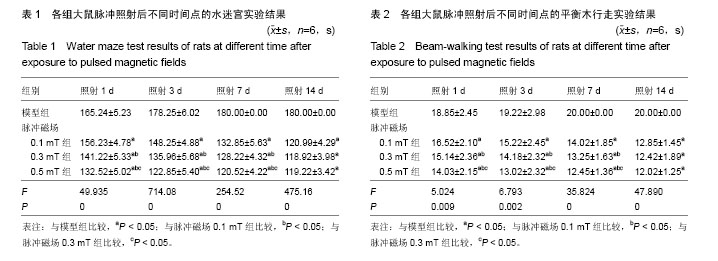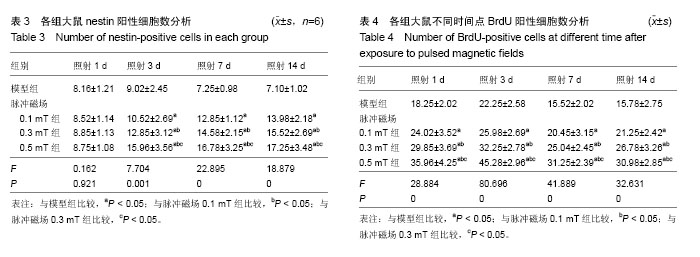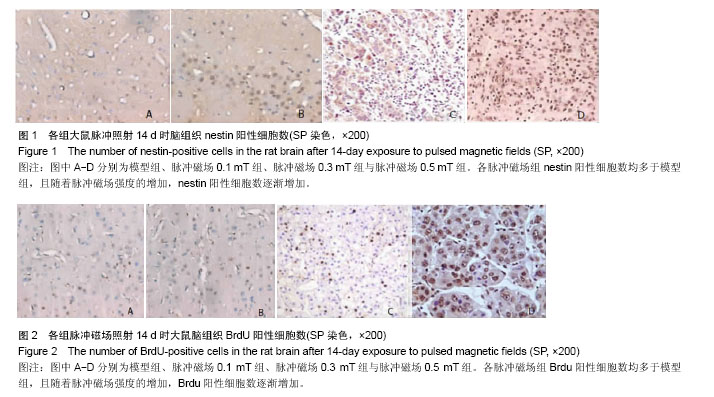| [1] 李侠,张磊,陈燕伟,等.852例开放性颅脑损伤的临床救治经验[J].中华神经医学杂志,2014,13(5):451-455.[2] 李春伟,伊志强,李良,等.重型创伤性颅脑损伤的治疗进展[J].中国微创外科杂志,2016,16(7):656-660.[3] 叶玉勤,贺晓生.内源性神经干细胞参与神经再生的分子影像学研究进展[J].中华神经医学杂志,2014,13(6):639-642.[4] Alabovsky VV,Kudryshov YB,Vinokurov AA,et al.Radio Frequency Electromagnetic Field Effect on the State of Na+/Ca2+ Exchange in the Isolated Rat Heart.Radiats Biol Radioecol.2016;56(2):171-176.[5] Zhou Y,Qiu Bland GZ,et al.Effects of electromagnetic pulse exposure on gelatinase of blood-brain barrier in vitro. Electromagn Biol Med.2016;29(2):1-7.[6] Kranjc S,Kranjc M,Scancar J,et al.Electrochemotherapy by pulsed electromagnetic field treatment (PEMF) in mouse melanoma B16F10 in vivo.Radiol Oncol.2016;50(1):39-48.[7] Jiang DP,Li JH,Zhang J,et al.Long-term electromagnetic pulse exposure induces Abeta deposition and cognitive dysfunction through oxidative stress and overexpression of APP and BACE1.Brain Res.2016;1642(2):10-19.[8] Afshari D, Moradian N, Khalili M, et al. Evaluation of pulsing magnetic field effects on paresthesia in multiple sclerosis patients, a randomized, double-blind, parallel-group clinical trial. Clin Neurol Neurosurg. 2016;149(2):171-174.[9] 陈斌,陶静,黄佳,等.从Notch通路探讨电针促进局灶性脑缺血再灌注大鼠海马神经干细胞增殖的作用机制[J].中国康复医学杂志,2014,29(5):399-404.[10] Guerriero F, Ricevuti G.Extremely low frequency electromagnetic felds stimulation modulates autoimmunity and immune responses: a possible immuno-modulatory therapeutic effect in neurodegenerative diseases.Neural Regen Res.2016;11(12): 1888-1895.[11] Zhang F,Duan X,Lu L,et al.In Vivo Targeted MR Imaging of Endogenous Neural Stem Cells in Ischemic Stroke. Molecules. 2016;21(9):143-145.[12] Klein R,Mahlberg N,Ohren M,etal.The Neural Cell Adhesion Molecule-Derived (NCAM)-Peptide FG Loop(FGL)Mobilizes Endogenous Neural Stem Cells and Promotes Endogenous Regenerative Capacity after Stroke.J Neuroimmune Pharmacol. 2016;8(5):85-86.[13] Nakatomi H,Ochi T,Saito N.Endogenous neural stem cell mobilization with intraventricular growth factor administration. Nihon Rinsho.2016;74(4):655-660.[14] Jiang S,Chen W,Zhang Y,etal.Acupuncture Induces the Proliferation and Differentiation of Endogenous Neural Stem Cells in Rats with Traumatic Brain Injury].Evid Based Complement Alternat Med.2016;20(2):89-92.[15] 蒋婷,许涛,向威,等.脉冲强磁场诱导体外新生大鼠神经干细胞向神经元方向分化[J].中华物理医学与康复杂志,2014,36(10): 740-744.[16] Ma F,Zhu T,Xu F,et al.Neural stem/progenitor cells on collagen with anchored basic fibroblast growth factor as potential natural nerve conduits for facial nerve regeneration. Acta Biomater. 2016;8(5):78-80.[17] Ye LJ,Bian H,Fan YD,et al.Rhesus monkey neural stem cell transplantation promotes neural regeneration in rats with hippocampal lesions.Neural Regen Res.2016;11(9):1464- 1470.[18] Li QQ,Qiao GQ,Ma J,et al.Cortical neurogenesis in adult rats after ischemic brain injury: most new neurons fail to mature. Neural Regen Res. 2015;10(2): 277-285.[19] Yao Y,Zheng XR,Zhang SS,et al.Transplantation of vascular endothelial growth factor-modified neural stem/progenitor cells promotes the recovery of neurological function following hypoxic-ischemic brain damage.Neural Regen Res.2016; 11(9):1456-1463.[20] Ye Y,Peng YR,Hu SQ,et al.In Vitro Differentiation of Bone Marrow Mesenchymal Stem Cells into Neuron-Like Cells by Cerebrospinal Fluid Improves Motor Function of Middle Cerebral Artery Occlusion Rats.Front Neurol.2016;7(5): 183-185.[21] Kim JY,Lee JH,Sun W.Isolation and Culture of Adult Neural Stem Cells from the Mouse Subcallosal Zone.J Vis Exp. 2016;15(118):78-80.[22] Gonzalez R,Garitaonandia I,Poustovoitov M,et al.Neural Stem Cells Derived From Human Parthenogenetic Stem Cells Engraft and Promote Recovery in a Nonhuman Primate Model of Parkinsons Disease.Cell Transplant.2016; 25(11): 1945-1966.[23] Alizadeh R,Hassanzadeh G,Joghataei MT,et al.In vitro differentiation of neural stem cells derived from human olfactory bulb into dopaminergic-like neurons.Eur J Neurosci. 2016;17(2):52-58.[24] 杨永凯,张帆,陈春美,等.高压氧对大鼠颅脑损伤后海马区神经干细胞增殖分化的影响[J].中华实验外科杂志,2016,33(11): 2543-2545.[25] 隋立森,余佳彬,姜晓丹,等.大鼠创伤性颅脑损伤后脑室下区内源性神经干细胞的增殖与分化[J].南方医科大学学报,2016,36(8): 1094-1099.[26] Kandalam S,Sindji L,Delcroix GJ,et al.Pharmacologically active microcarriers delivering BDNF within a hydrogel: Novel strategy for human bone marrow-derived stem cells neural/neuronal differentiation guidance and therapeutic secretome enhancement.Acta Biomater.2016;15(2):89-90.[27] Wang X,Seekaew P,Gao X,et al.Traumatic Brain Injury Stimulates Neural Stem Cell Proliferation via Mammalian Target of Rapamycin Signaling Pathway Activation. eNeuro. 2016;3(5):78-80.[28] Malloy KE,Li J,Choudhury GR,et al.Magnetic Resonance Imaging-Guided Delivery of Neural Stem Cells Into the Basal Ganglia of Nonhuman Primates Reveals a Pulsatile Mode of Cell Dispersion.Stem Cells Transl Med.2016;18(4):85-86.[29] 黄佳,郑薏,姚建宁,等.MicroRNA-9调控室管膜下区干细胞增殖在电针治疗局灶性脑缺血中的作用[J].中国康复理论与实践, 2016,22(11):1252-1258.[30] Tomokiyo A,Hynes K,Ng J,et al.Generation of Neural Crest-Like Cells From Human Periodontal Ligament Cell-Derived Induced Pluripotent Stem Cells.J Cell Physiol. 2017;232(2):402-416.[31] Glud AN,Bjarkam CR,Azimi N,et al.Feasibility of Three-Dimensional Placement of Human Therapeutic Stem Cells Using the Intracerebral Microinjection Instrument. Neuromodulation.2016;19(7):708-716. [32] Sui LS,Yu JB,Jiang XD.Proliferation and differentiation of endogenous neural stem cells in subventricular zone in rats after traumatic craniocerebral injury.Nan Fang Yi Ke Da Xue Xue Bao.2016;36(8):1094-1099. [33] Haus DL,López-Velázquez L,Gold EM,et al.Transplantation of human neural stem cells restores cognition in an immunodeficient rodent model of traumatic brain injury.Exp Neurol.2016;281:1-16.[34] Zhou HX,Liu ZG,Liu XJ,et al.Umbilical cord-derived mesenchymal stem cell transplantation combined with hyperbaric oxygen treatment for repair of traumatic brain injury.Neural Regen Res.2016;11(1):107-113. [35] Patel K,Sun D.Strategies targeting endogenous neurogenic cell response to improve recovery following traumatic brain injury.Brain Res.2016;1640(Pt A):104-113. [36] Wei ZZ,Lee JH,Zhang Y,et al.Intracranial Transplantation of Hypoxia-Preconditioned iPSC-Derived Neural Progenitor Cells Alleviates Neuropsychiatric Defects After Traumatic Brain Injury in Juvenile Rats.Cell Transplant. 2016;25(5): 797-809. [37] Koutsoudaki PN,Papastefanaki F,Stamatakis A,et al.Neural stem/progenitor cells differentiate into oligodendrocytes, reduce inflammation, and ameliorate learning deficits after transplantation in a mouse model of traumatic brain injury. Glia.2016;64(5):763-779. [38] Kim JY,Choi K,Shaker MR,et al.Promotion of Cortical Neurogenesis from the Neural Stem Cells in the Adult Mouse Subcallosal Zone.Stem Cells.2016;34(4):888-901.[39] Bohrer C,Pfurr S,Mammadzada K,et al.The balance of Id3 and E47 determines neural stem/precursor cell differentiation into astrocytes.EMBO J. 2015;34(22):2804-2819. [40] Zhao ML,Chen YS,Li XH,et al.Effect of chemical microenvironment after traumatic brain injury on temperature-sensitive umbilical cord mesenchymal stem cells.Zhongguo Ying Yong Sheng Li Xue Za Zhi.2015; 31(3):207-210,215. |
.jpg)



.jpg)